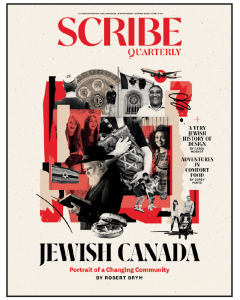HAMILTON — Edie Rochkin remembers helping her mother set the table for Shabbat each Friday night.
 “We would never know how many [places] to set. Dad would go to shul and bring people home who had nowhere to go,” she says in the DVD, Jewish Hamilton, the Way We Were.
“We would never know how many [places] to set. Dad would go to shul and bring people home who had nowhere to go,” she says in the DVD, Jewish Hamilton, the Way We Were.
Rochkin is one of about 40 people interviewed for the DVD detailing Jewish life in Hamilton in the first half of the 20th century.
Top: Wendy Schneider and Billy Shaffir have volunteered many hours over the last three years to produce Jewish Hamilton, The Way We Were. [Abigail Cukier photo]
Bottom: Abraham and Bella Freeman standing on either side of their niece Ruth Charney from Toronto. The child is Jeremy Freeman (called Jerry).
When Wendy Schneider, co-president of the Beth Jacob synagogue and editor of the Hamilton Jewish News, began gathering an oral account of her family’s history, she had an idea – why not gather information from many families to paint a picture of Jewish life in the city?
Schneider asked her friend Billy Shaffir, a sociology professor at McMaster University, for his help – and his video recorder.
McMaster University, for his help – and his video recorder.
For about three years, the two have been volunteering their time to visit and interview Jewish seniors in the area.
“Everyone received us so warmly and thought it was a great idea,” said Schneider. “It clearly resonates with the people we’ve met.
“It’s important to capture that period of vibrancy. Hamilton was a great place to grow up. If you don’t capture that, it’s lost.”
However, when trying to raise funds for the project, the two were at first greeted with a lukewarm reception. They held a public screening of the demo DVD this fall at Beth Jacob and crossed their fingers.
“We had a way bigger turnout than we expected. About 120 people of all ages came out,” Schneider said. “It was an absolutely magical evening. People were talking and laughing. The response was so delightful, the joy and laughter. It was very fulfilling for us.
“Then we knew it was worthwhile. People really connected to this.”
Shaffir moved from Montreal to Hamilton in the 1970s and raised his family here, and Schneider grew up in Hamilton, but neither knew very much about the city’s Jewish roots.
“It was really an eye-opener to see where they shopped, who they dated and how vibrant it was,” Shaffir said. “There were four [synagogues] built by people with no formal education. These institutions were established by people who were workers. It’s a tremendous credit to them.”
The synagogues were on Hunter, Hess, Ferguson and Cannon streets, and in the DVD, Helen Yellin remembers the beauty of the Cannon Street synagogue.
“It was built of the finest woods. They had three chandeliers in there that were so magnificent. I think they’re in some ritzy restaurants in Toronto now.
“The pedlars, the poor people built that shul.”
She calls the Ferguson shul, the broigasa shul, the ‘angry’ shul.
“If somebody couldn’t get along with people in their shul, they went there. You get three Jews, you get four shuls,” she laughed.
Hamilton’s present downtown area, bounded by York Boulevard and Barton, John to Bay streets was the centre of Hamilton’s Jewish area with thriving kosher butchers, fruit companies and delicatessens like Boleslawsky’s, which Rochkin said became like a club at night. Young people spent countless hours at the Jewish Community Centre, which moved from Vine to John to Delaware, producing plays, doing arts and crafts, exercising and going to dances.
About 2,500 Jews lived in Hamilton at that time. Even though the Jewish population has almost doubled to more than 4,000, the vibrant centre and many businesses are no longer here. The synagogues have moved west from the downtown.
Schneider says while it’s a joy for the storytellers to reminisce, it’s exciting for the younger generation to get a sense of what the community was like.
She and Shaffir are devoting their time “for the love of it” and have given the uncut interviews to each family to keep.
They are not always happy memories. Some remember when areas of Hamilton had covenants that barred Jews, and there was the teacher who could not advance to principal because he was Jewish. Jews could shop at Eaton’s, but not work there.
But Shannon Shapiro has fond memories of being part of the early Hamilton Jewish community.
“It was a wonderful time. We weren’t what I’d say, prosperous, but we were happy, very happy.”
Those sentiments shine through in Jewish Hamilton, the Way We Were.
The completed DVD will include an interactive table of contents, allowing viewers to click to a specific area, archival photos, interviews and census data.
Schneider and Shaffir have raised about $19,000 so far, with a goal of $30,000 total. All funds raised will go toward production costs. Donors will receive a charitable tax receipt.
For information or to donate, call (905) 628-0058 or e-mail [email protected]






